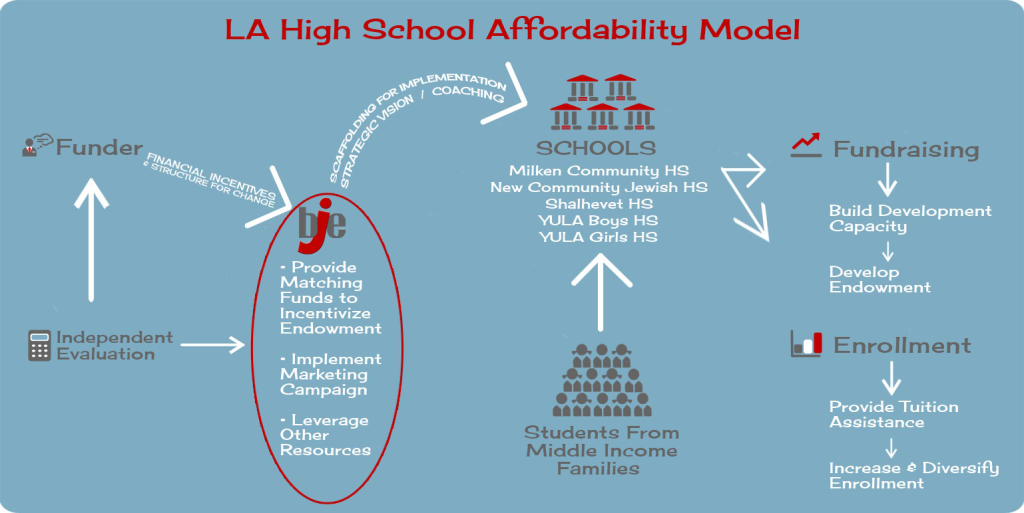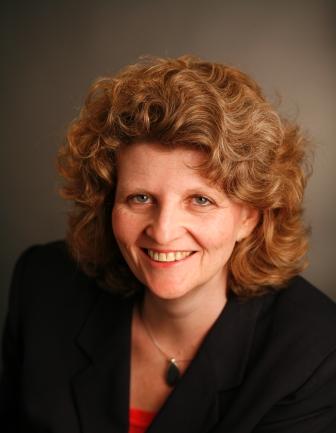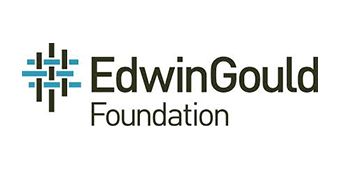A Model of Affordability Introducing the Los Angeles High School Affordability Initiative
In September, 2008, with generous funding from the Jim Joseph Foundation, BJE: Builders of Jewish Education (BJE) in Los Angeles and five local Jewish high schools, prepared to embark on a remarkable and challenging journey. Our goal, collectively, was to build $21.25 million in high school endowment funds over six years to help schools increase and diversify their enrollment, and to develop a model—adaptable for other communities—to support middle-income families who wanted to enroll their children in Jewish high schools.
Known as the Los Angeles High School Affordability Initiative (LAHSAI), the framework was conceived earlier in 2008, with a $12.7 million grant from the Jim Joseph Foundation as the catalyst. No one knew at the time that the market would crash a few months later. Although the economy was in a deep rut, we moved forward with our partners.
Our first step was to deposit $4.25 million into an endowment fund—separate from the Jim Joseph Foundation funding—to provide a 25 percent match to the subsequent dollars raised by the schools. This was a stipulation put in place by the Foundation to create communal buy-in from the outset of the initiative. Fortunately, the Lainer family and several other visionary donors put $4.25 million into the new Simha and Sara Lainer Day School Endowment Fund. By June, 2009, we were ready to implement the model.
Figure 1
In this framework, all parties were linked closely together and, to be truthful, all parties felt some trepidation in those early months. We were attempting to change both the culture of fundraising and the culture of giving. There was no culture of endowment or planned giving and few schools had created a development infrastructure to think strategically, beyond annual giving, to diversify revenue streams and address long-term sustainability. In very difficult financial times, could we facilitate raising millions of dollars for endowment? Could we transform schools whose long-ingrained habits of spending nearly every dollar on operations were focused primarily on short-term needs?
Because of the multi-faceted nature of the initiative’s goals, we needed to pursue multiple strategies. This included educating lay and professional school leadership about the value of endowment, and providing school development staff with the tools and training to build and execute an endowment plan and campaign. We knew that to succeed in major endowment gift solicitation, development staff and lay leadership would have to feel passionate about endowment and convey that passion to new and current donors. Could we teach leadership how to approach donors about endowment? And more importantly, could we get them to believe wholeheartedly in the need for endowment?
Our early-stage planning meetings were accompanied by numerous seminars and workshops, coaching sessions, and conferences with boards and lay leadership. We covered topics such as strategic planning, how to assess donor capacity, how to cultivate donors, stewardship and donor recognition, and utilizing a holistic schoolwide campaign approach. One important lesson of many from LAHSAI is that progress and true change in culture takes time. Throughout the first two years, schools would at times fall back on their traditional ways of fundraising. Development staff also turned over repeatedly at some of the schools and we had to begin anew with our trainings each September.
We also learned that while the schools were collectively part of one initiative, they each had their own characteristics and challenges. The school with the most development infrastructure in place prior to the project moved very quickly. Others progressed more slowly, with their endowment fundraising lagging behind yearly campaigns, financial aid and capital efforts. Critically, the structure of the grant motivated all schools to stay the course in order to access both grant funding and the maximum amount of funding available through the Lainer matching funds. And along with coaching and providing strategic vision, BJE certainly had to push and prod schools to follow the course we all charted to reach important financial benchmarks. When schools felt overwhelmed, we offered whatever training, coaching, support or help they asked for or needed to move the bar forward.
About six months past the project’s midpoint, in January 2013, we hit a turning point in the cultural change that was such an important element of the LAHSAI goal. At a group evaluation meeting between lay and professional leadership, BJE, and the Jim Joseph Foundation, the commitment and passion from school leadership emerged, unabashed.
“This grant created a ‘sea-change,’ a fundamental culture change in how we think about endowment and the future.”
“Being part of this project has focused us…on the future and changed the landscape of giving.”
“This project has been stunning in that it made real what must be done.”
“Without this project, we would not be building for the future:”
“We have learned that endowment is the most important thing we can do for our schools.”
“The grant re-educated us about long-term need.”
The excitement in the room was palpable. We had turned the corner! Leadership truly understood the critical importance of endowment in securing their schools’ future. While this was significant, we still had to support the schools to raise the required endowment funds that were scheduled to grow larger each year. At the same time, we helped them create a multi-year strategic plan and the infrastructure that would be in place long after the project ended. Trained development staff combined with a shift in cultural ultimately would help the schools meet their project goals.
Figure 2: Breakdown of the $12.7 million grant for the six-year initiative
The necessary cultural changes that led to the endowments’ growth resulted from BJE and the Jim Joseph Foundation first recognizing the nature and magnitude of the challenge and providing the resources to succeed. BJE, as the agency on the ground, worked intently with each school to create the fundamental changes in the way fundraising was both framed and conducted. We knew it could take years and a tremendous number of meetings, very long conversations and a whole lot of sophisticated training. And it did. As of June, 2014, the five LAHSAI high schools will have collectively raised $14,241,683 in endowment pledges, nearly 83 percent of their end goal, with one year left to go.
We are now pleased to share the LAHSAI model with other communities across the country. At www.LAHighSchoolAffordability.org we are transparent about every facet of this initiative, including: the financial structure; the professional development; the relationships between all involved entities; and the challenges we experienced regarding recruitment and enrollment in high schools with these grants.
The website also examines the readiness factors we believe best position a community to achieve positive outcomes. This includes an understanding of the cost of being engaged Jewishly in a community; defining what middle-income affordability is; having stability at your community’s schools; and having a mechanism in place to provide “communal scaffolding;” among other factors.
The day school affordability question has been examined many times over. We believe this model offers important insights, ideas, and lessons for all kinds and sizes of communities. We look forward to a continued dialogue and to continue to share lessons learned from our experience with the LA High School Affordability Initiative.






